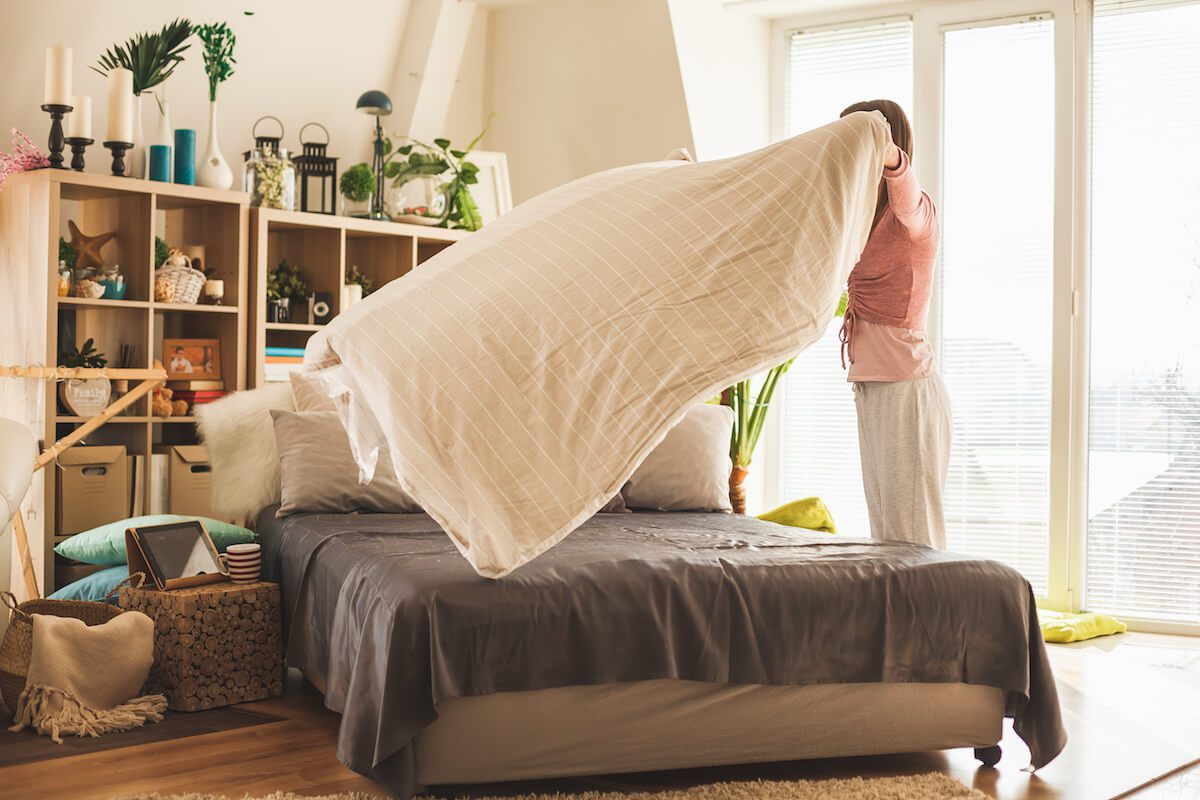With the advent of the new decade, one of the biggest lessons we seem to keep learning more about is the importance of going green.
“Going green” means seeking out knowledge and habits that help protect the environment and sustain resources for generations to follow.
In your home, going green can translate to a few different practices:
- Recycling & composting
- Upcycling or repurposing materials for other uses
- Detoxing your air
- Limiting natural resource use, like water and energy
By keeping these general rules in mind, you can go through each room of your house to make sure it meets eco-friendly standards.
While the rules are consistent room by room, your strategies for going green can vary. That’s why we’ve provided a breakdown of how to make every space in your house better for the environment.
Today, we focus on that cozy refuge you call your bedroom.
While you may not use much water or energy in your room compared to your kitchen, there are still plenty of opportunities to improve the energy use and sustainability of your bedroom.
Conveniently, many things we do for the earth are good for our health, too. Encountering less toxins means a happier, cleaner body as much as it means a happier, cleaner world.
Here’s how you can go green in your bedroom to help create a healthier and more eco-friendly lifestyle.
Upcycled Furniture

Think of up cycling as “creative recycling.” While recycling refers to the processing of an item’s material to turn it into new items, upcycling puts the process of creating the new from the old in your hands.
You have the power to use your creativity to turn something that’s seen better days and is headed for the trash into something new and useful.
Upcycling old things keeps them out of landfills, which is growing increasingly important.
We’re currently facing a trash crisis. Every year about 1.3 billion tons of waste is produced. It’s expected this amount will increase to 4 billion tons by 2100 when we’re already running out of room for it all.
As waste increases, pollution seeps into water and soil supplies. Respiratory infections are also likely due to the fumes from waste being burned. Crowded landfills are a threat to health and safety everywhere.
Upcycling can be an especially fun project when it comes to your bedroom furniture. There’s nothing like taking a ratty old chair on its last leg and turning it into a comfy, fashionable accessory for your bedroom.
If this is your first time upcycling furniture, you’ll want to be prepared with a bit of basic knowledge before you begin:
- Before you get started, make sure you have an idea of each step and the tools needed for it. You’ll also want to be sure the piece you’re upcycling is clean so you can avoid a re-do if you accidentally paint over grime.
- Choose quality tools. It’s worth a few extra dollars to have handy things like paintbrushes with bristles that stay intact.
- Remember whatever you’d like to upcycle can have many purposes! Those old suitcases can become your new nightstand, or that old window panel on your garage can become a new mirror or memo board! Think outside the box.
- Be sure to do a coating of non-toxic varnish or wax on all the hard surfaces you finish to preserve them longer.
Once you have the basics down, it’s time to collect all those pieces of furniture and odds and ends you have lying around…you can epicycle anything from an old ladder to a bicycle tire. Once you have an idea, get to crafting!
Use Organic Cotton

Much like many foods we eat, many fabrics contain pesticides and herbicides. Depending on how they were produced, certain fabrics can have other chemicals that are bad for your skin (and your body, as prolonged exposure can allow your body to absorb the chemicals which can cause them to leak into your bloodstream).
The production of some fabrics and materials can also use up a lot of valuable resources in creation. As such, by choosing more sustainably-sourced fabrics for your bedding, curtains, and more, you can take a step in making your bedroom more eco-friendly (and healthier for you, too!)
Fabrics to avoid include:
- Rayon: Rayon is made from wood pulp, and the mass production of it contributes to deforestation.
- Nylon: Nylon is completely synthetic, and is processed using harmful chemicals like petroleum and formaldehyde.
- Polyester: Like Nylon, Polyester is petroleum based, therefore it’s not easily biodegradable. You should especially avoid nylon and polyester if you’re trying to have children, as certain tests have linked synthetic fabric to infertility.
Your best bet? Organic cotton. While cotton is natural and biodegradable, inorganic cotton often contains pesticides.
Change your sheets, pajamas, curtains, and mattress to ones made with organic cotton, and rest easy knowing you’re cutting harmful carcinogens and chemicals out of your day to day routine.
Avoid Temperature Controls
The Unites States uses around 25% of global energy supplies. Some of that energy we use in heating and cooling rooms, which contributes to the emission of greenhouse gases.
Greenhouse gases are gases that trap heat in the earth’s atmosphere. They’re useful in that, without them, the earth would be too cold to live on. But too much of these gases can cause extreme temperature shifts, leading to a high risks of natural disaster.
Conserving energy has a lot of perks for you and the environment:
- It reduces your heating expenses
- If everyone helps conserve energy less power plants need to be built. Power plants can create air pollution.
- You’re concerting resources for future generations.
To conserve as much energy as you can, avoid using air conditioning and household heating.
Plan other ways to heat and cool your room.
You can keep your room cool in the summer by opening your windows and blinds at night, then closing them during the day. This traps the cool air of the night in your room, while keeping the daytime sun from heating it back up.
Keep your bedroom door closed to keep the cool air trapped in your room. On especially hot days, you can put a bowl of ice water behind a fan to create an eco-friendly A/C effect.
In the cooler months, keep your blinds open during the day to allow sunlight to warm up your room. Close them at night to keep cold air from leaking through your windows, and be sure to be stock up on cozy blankets, rugs and pajamas!
Life hack: Make sure your fan is rotating clockwise, as this pulls warm air from the ceiling down into your bedroom. In the summer, turning it counter clockwise helps raise cool air!
Nontoxic Paint and Finishes
Certain paint and finishes found on furniture, walls, and flooring can emit VOCs, or Volatile Organic Compounds.
Breathing in VOCs can cause short-term health effects like nose and throat irritation and nausea. They can also have long term effects, like damage to your central nervous system or even cancer.
Flooring options to help you avoid VOCs include:
- Bamboo
- Hardwoods (with VOC-free finish)
- Tile
- Natural fiber carpet
When it comes to paint, non-toxic paints have more benefits than helping you avoid VOCs.
- They’re better for the environment due to less contaminants
- Unlike other paints, they’re not considered hazardous waste, making them easier to dispose of
- They’re water based, so you can clean up any errors with warm, soapy water
A few days of revamping your paints and finishes can help you breathe easier with the knowledge that you’re benefiting your health and the environment.
Use Energy-Efficient Lighting
Think about how many times you turn your bedroom lights on and off throughout your daily routine. Like heating and cooling, the lights you’re using come from limited energy resources.
These days, there are plenty of options for eco-friendly lighting sources to replace your incandescent lights.
- LEDs or light emitting diodes
- Halogen
- CFLs or compact fluorescent lamps
All of these options use 25%-80% less energy than traditional incandescents, and last 3-25 times longer.
If you’re looking for a more long-term investment, consider skylights. Thanks to a new invention, the Solatube Tubular Daylight Systems, you can use outdoor lighting in places light from regular skylights can’t reach like closets.
These “light channeling tunnels” funnel natural light into hard-to-reach areas, filtering out harmful rays in doing so!
Conserving energy and reducing waste is important to the health of the environment, but it’s also important for your own health, too. And just a few changes in your habits and home environment can help you live a healthier, eco-friendly life.
Not only will these changes make your room feel fresh and fun, but your body will also thank you.
Keep out your supplies, because it’s time to ensure the other rooms in your house are as “green” as your toxin-free, energy conscious bedroom.


